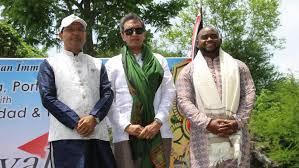180th Indian Arrival Day celebrated in Trinidad and Tobago Port of Spain (Trinidad and Tobago)

Trinidad and Tobago came alive on Friday with color, culture, and commemoration. The nation marked the 180th anniversary of Indian Arrival Day. This national holiday honors the arrival of the first indentured Indian laborers to the islands in 1845 aboard the Fatel Razack.
This year’s celebration was vibrant and meaningful. It marked nearly two centuries of Indian presence in the twin-island Caribbean nation. Thousands gathered across Port of Spain, Chaguanas, and other cities. They joined in events celebrating Indo-Trinidadian heritage.
Historical Significance
Indian Arrival Day remembers the landing of the first Indian immigrants. They were brought to Trinidad to work on sugar plantations after slavery was abolished. Most came from Uttar Pradesh and Bihar. These immigrants faced long, hard voyages and tough conditions. However, they built new lives and generations in the Caribbean.
Over the past 180 years, their descendants shaped the country’s identity. Indo-Trinidadians play a major role in politics, business, arts, and academia today. They are a vital part of the nation’s growth.
Highlights of the 2025 Celebration
The theme this year was “Resilience, Culture, and Unity.” It reflected the strength of Indo-Trinidadians and their harmony with other communities.
1. Floral Tributes and Prayer Services
Early morning began with pujas (prayer rituals) and floral offerings at temples and historical sites. Places like the Indian Caribbean Museum in Waterloo saw many devotees. They lit diyas (lamps) and performed aarti to honor ancestors.
2. Parade of Culture and Tradition
In Chaguanas, a colorful parade took place. People wore traditional Indian clothes like sarees, kurtas, and lehengas. Tassa drummers and dancers performed along the streets. Schoolchildren reenacted the arrival of the Fatel Razack.
3. Food Festivals and Cultural Shows
Food vendors served classic Indian treats such as roti, doubles, pholourie, and aloo pies. There were cultural shows too. These included classical Indian dances like Kathak and Bharatanatyam. Chutney music and Bollywood-style performances added to the festivities.
An outdoor concert in Queen’s Park Savannah featured local and international Indo-Caribbean artists. The music united people from all backgrounds.
4. Speeches from Leaders
Leaders like President Christine Kangaloo, Prime Minister Dr. Keith Rowley, and Opposition Leader Kamla Persad-Bissessar spoke to the nation. They highlighted the importance of cultural preservation. They also praised Indo-Trinidadians for their contributions.
“Today, we celebrate not just a journey of the past but a living legacy of diversity and strength,” said Prime Minister Rowley.
Opposition Leader Persad-Bissessar urged more investment in cultural education. She emphasized engaging youth to keep the heritage alive.
Community Reflections
Many people expressed pride and reflection on their ancestors’ sacrifices.
“My grandfather told stories about his grandfather, who came as an indentured laborer. Now, I run a business and my children study at university. That’s the legacy we celebrate,” said Rajiv Maharaj from Port of Spain.
On social media, tributes poured in. Hashtags like #IndianArrivalDay180, #FatelRazack, and #IndoTriniPride trended nationwide.
Calls for Recognition and Dialogue
Although the celebrations were joyful, some voices called for deeper national discussions. They highlighted ongoing challenges faced by Indo-Trinidadians. They also requested better inclusion in education and media.
Cultural activists urged the government to preserve indentureship-era sites. They want Indo-Caribbean history taught more fully in schools.
Conclusion
The 180th Indian Arrival Day was more than a remembrance. It was a celebration of unity in diversity. From humble beginnings, Indo-Trinidadians have become a core part of the nation. Their story is one of resilience, culture, and community shaping a country’s future.






